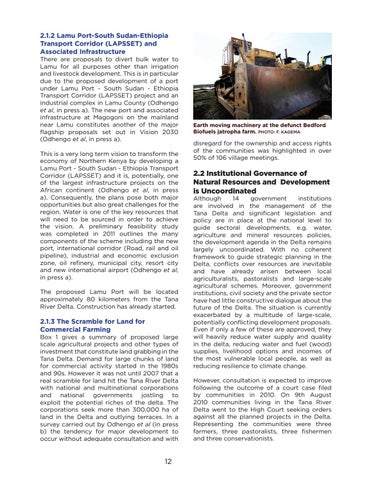2.1.2 Lamu Port-South Sudan-Ethiopia Transport Corridor (LAPSSET) and Associated Infrastructure
There are proposals to divert bulk water to Lamu for all purposes other than irrigation and livestock development. This is in particular due to the proposed development of a port under Lamu Port - South Sudan - Ethiopia Transport Corridor (LAPSSET) project and an industrial complex in Lamu County (Odhengo et al, in press a). The new port and associated infrastructure at Magogoni on the mainland near Lamu constitutes another of the major flagship proposals set out in Vision 2030 (Odhengo et al, in press a). This is a very long term vision to transform the economy of Northern Kenya by developing a Lamu Port - South Sudan - Ethiopia Transport Corridor (LAPSSET) and it is, potentially, one of the largest infrastructure projects on the African continent (Odhengo et al, in press a). Consequently, the plans pose both major opportunities but also great challenges for the region. Water is one of the key resources that will need to be sourced in order to achieve the vision. A preliminary feasibility study was completed in 2011 outlines the many components of the scheme including the new port, international corridor (Road, rail and oil pipeline), industrial and economic exclusion zone, oil refinery, municipal city, resort city and new international airport (Odhengo et al, in press a). The proposed Lamu Port will be located approximately 80 kilometers from the Tana River Delta. Construction has already started.
2.1.3 The Scramble for Land for Commercial Farming
Box 1 gives a summary of proposed large scale agricultural projects and other types of investment that constitute land grabbing in the Tana Delta. Demand for large chunks of land for commercial activity started in the 1980s and 90s. However it was not until 2007 that a real scramble for land hit the Tana River Delta with national and multinational corporations and national governments jostling to exploit the potential riches of the delta. The corporations seek more than 300,000 ha of land in the Delta and outlying terraces. In a survey carried out by Odhengo et al (in press b) the tendency for major development to occur without adequate consultation and with
12
Earth moving machinery at the defunct Bedford Biofuels jatropha farm. PHOTO: F. KAGEMA
disregard for the ownership and access rights of the communities was highlighted in over 50% of 106 village meetings.
2.2 Institutional Governance of Natural Resources and Development is Uncoordinated
Although 14 government institutions are involved in the management of the Tana Delta and significant legislation and policy are in place at the national level to guide sectoral developments, e.g. water, agriculture and mineral resources policies, the development agenda in the Delta remains largely uncoordinated. With no coherent framework to guide strategic planning in the Delta, conflicts over resources are inevitable and have already arisen between local agriculturalists, pastoralists and large-scale agricultural schemes. Moreover, government institutions, civil society and the private sector have had little constructive dialogue about the future of the Delta. The situation is currently exacerbated by a multitude of large-scale, potentially conflicting development proposals. Even if only a few of these are approved, they will heavily reduce water supply and quality in the delta, reducing water and fuel (wood) supplies, livelihood options and incomes of the most vulnerable local people, as well as reducing resilience to climate change. However, consultation is expected to improve following the outcome of a court case filed by communities in 2010. On 9th August 2010 communities living in the Tana River Delta went to the High Court seeking orders against all the planned projects in the Delta. Representing the communities were three farmers, three pastoralists, three fishermen and three conservationists.
